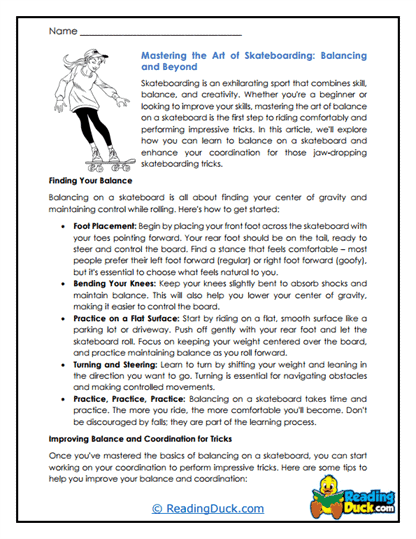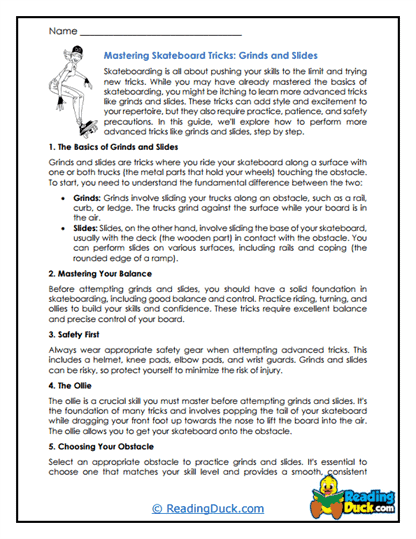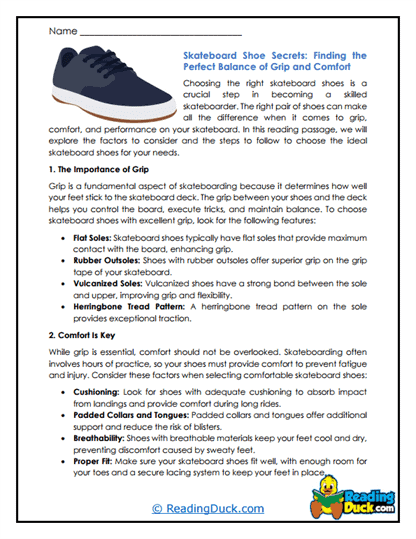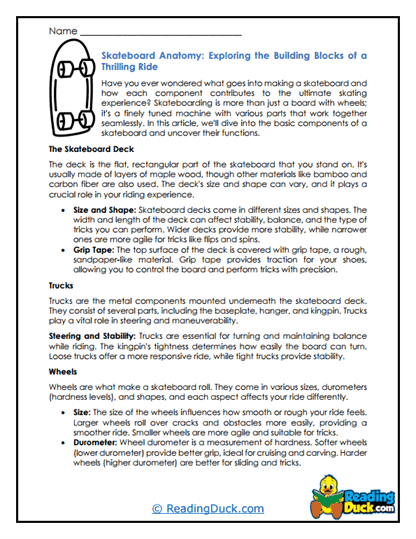Skateboarding Worksheets
About Our Skateboarding Worksheets
Our skateboarding worksheets introduce students to the dynamic and exciting world of skateboarding, a hobby that combines physical skill, creativity, and culture. These worksheets explore various aspects of skateboarding, from its history and cultural impact to the techniques and skills involved in mastering the sport. Whether students are seasoned skaters or new to the idea of skateboarding, this collection offers valuable insights and activities to deepen their understanding and appreciation of the sport.
All worksheets in the Hobbies category cover a variety of popular hobbies, organized into categories such as Board Games, Collecting, Cooking, Gardening, Photography, Quilting and Sewing, Skateboarding, Toys, Video Games, and Yoga. These topics reflect a broad spectrum of interests, ensuring there is something for every student to connect with and explore.
The Skateboarding Worksheets collection contains several worksheet sets, each focusing on one specific aspect of the topic. Each worksheet set includes:
- Multiple Choice Questions: These questions assess students’ comprehension of the reading passages, which cover topics such as the history of skateboarding, the physics behind skateboarding tricks, and the influence of skate culture on fashion and art. The multiple-choice format reinforces key concepts and ensures students grasp the essential details.
- Short Answer Questions: These prompts require students to apply their knowledge by explaining specific skateboarding techniques, describing the evolution of skateboarding over time, or discussing the impact of skateboarding on global culture. For example, students might be asked to explain the mechanics of an ollie, outline the rise of skateboarding as a popular sport, or discuss how skateboarding has influenced music and fashion trends.
- Open-Ended Questions: These questions encourage students to express their personal thoughts and opinions on topics related to skateboarding. Students might be asked to share their own experiences with skateboarding, reflect on what they find most appealing about the sport, or consider how skateboarding can be a form of self-expression. These questions allow students to connect with the material on a deeper level and explore their individual perspectives.
These worksheets are designed to enhance students' understanding of skateboarding while fostering a personal connection to the sport. By engaging with the content through various types of questions, students can better retain information and develop a genuine interest in skateboarding. Each worksheet includes an answer key to facilitate easy assessment. All of the worksheets are available as PDF files, making them accessible for electronic viewing, downloading, and printing.
Understanding the World of Skateboarding
Skateboarding is more than just a sport; it’s a culture, an art form, and a means of self-expression. These worksheets provide students with a comprehensive overview of skateboarding, covering its history, cultural significance, technical skills, and the science behind the tricks. Through these activities, students will gain a well-rounded understanding of what makes skateboarding such a unique and influential hobby.
Here are some of the key aspects of skateboarding that students will explore through these worksheets:
- The History and Evolution of Skateboarding: Understanding the origins and development of skateboarding helps students appreciate how it has grown from a niche activity to a global phenomenon. Topics covered include:
- The Birth of Skateboarding: Students will learn about how skateboarding began in the 1950s and 1960s, originating from surfers looking for a way to "surf" on land. This section covers the early years of skateboarding, including the creation of the first skateboards and the rise of skateboarding as a popular pastime.
- The Evolution of Skateboarding Equipment: Students will explore how skateboard design has evolved over the decades, from the simple wooden planks with roller skate wheels to the highly specialized boards used today. They will also learn about the development of protective gear, such as helmets and pads, and how these innovations have made skateboarding safer and more accessible.
- The Growth of Skateboarding Culture: The worksheets will discuss how skateboarding has influenced and been influenced by broader cultural trends, including the punk rock movement, the rise of streetwear fashion, and the emergence of skateboarding as a professional sport. Students will also learn about the role of skateboarding in shaping urban landscapes, with the creation of skateparks and the repurposing of public spaces for skateboarding.
- The Science of Skateboarding: Skateboarding is a physically demanding sport that requires an understanding of balance, motion, and physics. These worksheets will guide students through:
- Basic Physics of Skateboarding: Students will learn about the forces at play in skateboarding, such as gravity, friction, and momentum. They will explore how these forces affect the movement of a skateboard and how skaters use them to perform tricks.
- Understanding Skateboarding Tricks: The worksheets will break down popular skateboarding tricks, such as ollies, kickflips, and grinds, explaining the techniques and physics behind them. Students will gain a deeper appreciation for the skill and precision required to master these moves.
- Safety and Injury Prevention: Students will learn about the importance of safety in skateboarding, including the use of protective gear and the need to practice in safe environments. The worksheets will also cover common skateboarding injuries and how to prevent them.
- Skateboarding as a Form of Self-Expression: For many skaters, skateboarding is more than just a sport; it’s a way to express their individuality and creativity. These worksheets encourage students to explore the artistic and cultural aspects of skateboarding:
- Skateboard Art and Design: Students will learn about the art of skateboard design, from the graphics on the deck to the customization of wheels and trucks. They will have the opportunity to design their own skateboard deck, considering factors such as aesthetics, personal style, and functionality.
- The Influence of Skateboarding on Fashion: The worksheets will explore how skateboarding has influenced fashion trends, particularly in the areas of streetwear and footwear. Students will learn about iconic skate brands, such as Vans and Supreme, and how these brands have become symbols of skate culture.
- The Role of Music in Skateboarding: Music has always been an integral part of skateboarding culture. Students will explore the connection between skateboarding and various music genres, such as punk rock, hip-hop, and electronic music. They will also learn about the role of music in skate videos and how it enhances the overall skateboarding experience.
How to Effectively Use These Worksheets
To maximize the impact of these Skateboarding Worksheets, teachers and parents can implement various strategies to engage students and foster a deeper interest in skateboarding. Here are some tips on how to use these worksheets effectively:
- Incorporate Practical Skateboarding Sessions: Encourage students to apply what they’ve learned in the worksheets by practicing skateboarding skills. If possible, organize skateboarding sessions where students can try out different tricks and techniques under supervision. This hands-on approach not only reinforces the concepts covered in the worksheets but also helps students build confidence and improve their skateboarding abilities.
- Organize Group Discussions: Skateboarding is a social activity, and discussing the cultural and artistic aspects of the sport can help students appreciate its broader impact. Teachers can facilitate group discussions on topics such as the evolution of skateboarding, its influence on fashion and music, and the role of skateboarding in different communities. These discussions can help students connect with the material on a deeper level and encourage them to share their own experiences and perspectives.
- Integrate Skateboarding into Other Subjects: Skateboarding can be a fun and engaging way to teach concepts in subjects such as physics, art, and history. For example, students can apply their understanding of physics to analyze the mechanics of a skateboarding trick, or they can explore the history of skateboarding as part of a broader study of 20th-century culture. The worksheets provide a foundation of knowledge that can be built upon in these interdisciplinary activities.
- Encourage Creative Projects: Skateboarding is a highly creative sport, and students can express their creativity through various projects. Teachers can encourage students to design their own skateboard decks, create skateboarding-themed art, or produce a short skate video. These projects allow students to combine their interests in skateboarding with their artistic talents, resulting in a deeper engagement with the material.
- Promote Skateboarding Safety: Emphasizing the importance of safety is crucial when teaching students about skateboarding. The worksheets can be used to discuss the proper use of protective gear, the importance of practicing in safe environments, and the need to follow local skateboarding regulations. Teachers and parents can also provide guidance on how to avoid common skateboarding injuries and encourage safe practices both in and out of the classroom.
- Host Skateboarding Workshops: If possible, organize workshops where students can learn from experienced skateboarders. These workshops can cover topics such as basic skateboarding techniques, advanced tricks, and the cultural significance of skateboarding. Students can benefit from hands-on instruction and personalized feedback, which can enhance their understanding of the sport and inspire them to pursue skateboarding further.
- Explore the Cultural Impact of Skateboarding: Skateboarding has a rich cultural history that can be explored through these worksheets. Teachers can organize research projects or presentations where students delve into the impact of skateboarding on various aspects of culture, such as fashion, music, and art. By understanding the broader cultural context of skateboarding, students can gain a deeper appreciation for the sport and its significance in the world.
By using these Skateboarding Worksheets in conjunction with practical activities, teachers and parents can help students develop a well-rounded understanding of skateboarding. These activities not only teach valuable skills but also provide an opportunity for students to express themselves creatively and connect with others who share their interest in skateboarding.
Overall, the Skateboarding Worksheets offer a comprehensive introduction to the world of skateboarding. They are designed to inspire students to explore the sport, develop practical skills, and appreciate the cultural significance of skateboarding. Whether students are just beginning their skateboarding journey or looking to deepen their knowledge, these worksheets provide valuable insights and practical knowledge that will enhance their understanding and enjoyment of skateboarding.









